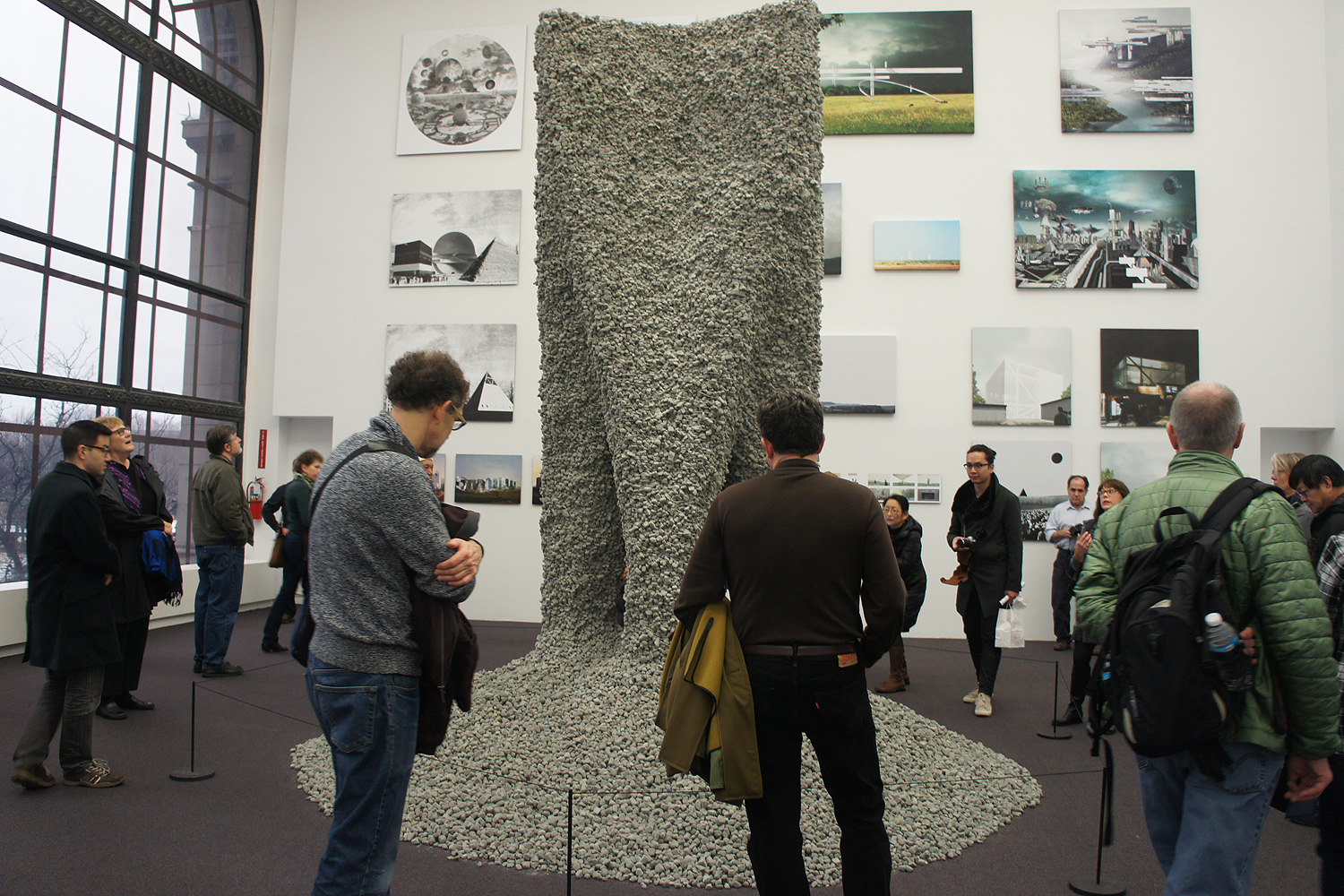As the Chicago Architectural Biennial heads towards its close on January 3, it's likely to get an influx of visitors over the holidays. The event, most of which takes place at the Chicago Cultural Center, is a big deal—an attempt to match the legendary Venice Bienniale and to carve out a space in Chicago's specialty within the crowded field of art biennials.
But what will you see at the event, anyway?
You can start with a living room.
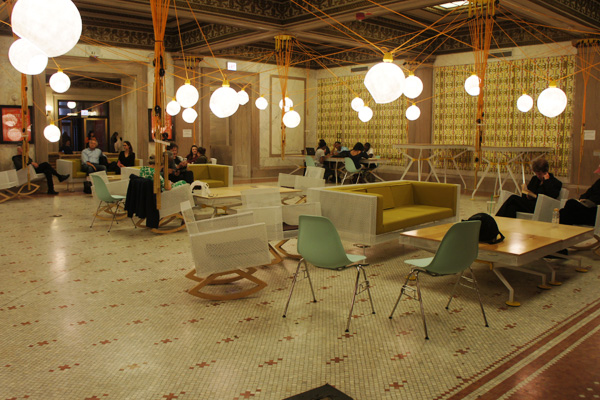
The Mexican firm Pedro&Juana started with the idea of the Chicago Cultural Center as the "living room of the city," a good an idea as any for the hodgepodge of edification the building became after it ceased to be the city's main library.
Amanda Williams, an artist and architect from Auburn Gresham and a biennial participant with her Color(ed) Theory series, suggests starting here. "For people who don't have a particular in, how do they start?" she says. "That's why I love the living room, coming in to that first space. It's done so well, maybe, that people don't get what it's trying to do. It's really trying to embrace, from a distance, what the architects thought they understood that space to be."
Another way in is more conceptual: "Architecture is Everywhere," by Sou Fujimoto Architects. It doesn't look like much: pedestrian objects and tiny little plastic figures on little podiums with enigmatic phrases.
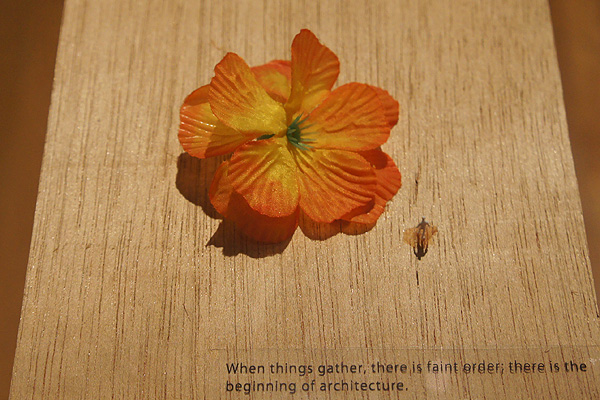
That's it. You might not even recognize it as "architecture" were it not for the thumbnail-sized figurines.
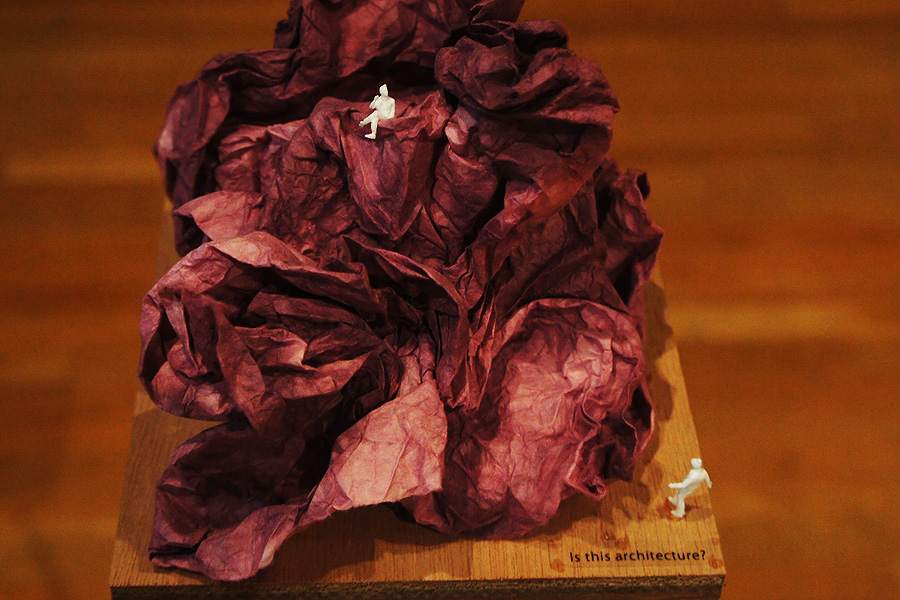
After you look at the Fujimoto pieces for awhile, you can see the architecture start to emerge. Like this: It looks like the beginnings of a Frank Gehry building, no?
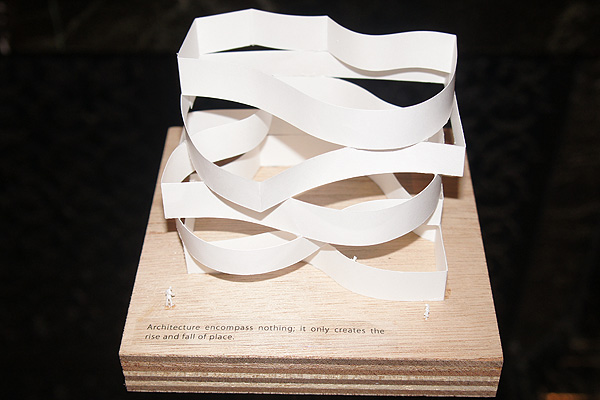
"It speaks more to the process of coming up with ideas and architectural expression, seeing architecture everywhere," Williams says. "[The exhibit] was delightful to me in that way—the celebration of the way in which we as practitioners within the built environment all operate. And seeing other people, from little kids to senior citizens nodding, going, 'oh, that's really great.'"
At the other end of the spectrum is Studio Gang's idea for a "Polis Station"—turning the 10th District police station into a multi-use facility that would include a law library, day care, and town hall. Jeanne Gang takes as her starting point the Final Report of the President's Task Force on 21st Century Policing, the result of President Obama's push for police reform. Gang's project asks: What would happen if you applied its recommendations to the built environment?
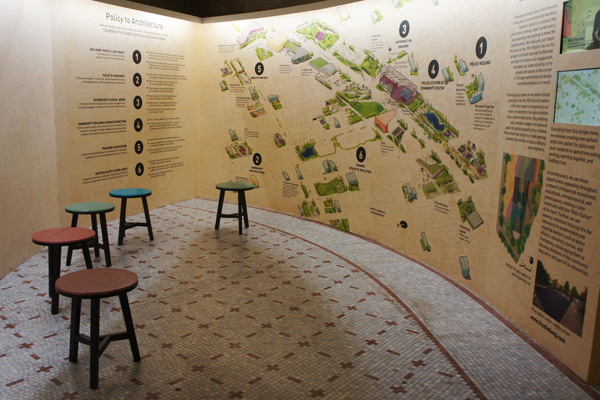
One half of Gang's exhibition lays out her idea, and how the firm would expand the idea of the Polis Station to the rest of the district—an interesting idea in itself, thinking of a police district not just as a bureaucratic limit but as a community ecosystem like a neighborhood.
The other half is the historical argument behind Gang's Polis Station idea. She follows the development of the modern police station from its beginnings, showing how the physical evolution of police stations paralleled the conceptual evolution of policing. It's an essay about policing.
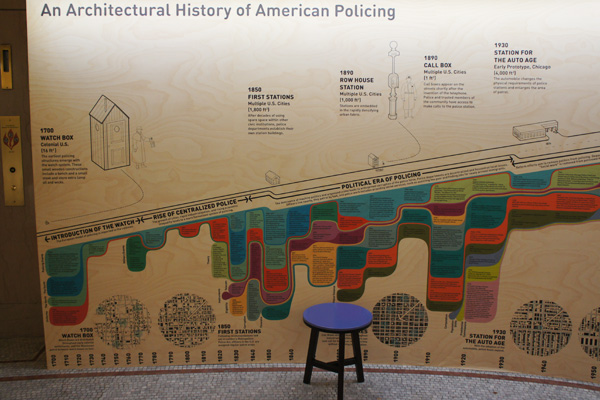
If contemporary policing follows the Final Report—if it starts to look like policing in Cincinnati, inclusive of community needs outside the enforcement of law and order—perhaps police stations will look like Gang's.
"It's a way of thinking about the world that includes buildings and the built environment, and also structures the world in many ways. These more speculative projects are as integral to architecture as built buildings," says Stuart Hicks, half of the Chicago firm Design With Company and another biennial participant. "Architecture encompasses a broad world of ideas that all relate to the constructed environment. Beyond just being able to point to an object like a building and say, that's architecture, to me, it's a body of ideas in the way that literature is a body of ideas."
Hicks and his colleague Allison Newmeyer contributed Late Entry to the Chicago Public Library Competition, inspired by Claes Oldenburg's Late Entry to the Chicago Tribune Tower Competition and a Stanley Tigerman exhibition of the same name. (The biennial's title, "The State of the Art of Architecture," also comes from a conference organized by Tigerman in 1977.) Tigerman lambasted the Harold Washington Library, one still ambivalently regarded by Chicagoans, as a design that "sends Chicago backwards… the kind of thinking that uses context to establish authority and uses verification of an earlier time to get over the insecurities of the natives of a city trying to seek authenticity."
So Design With Company took the idea and playfully blew it out.
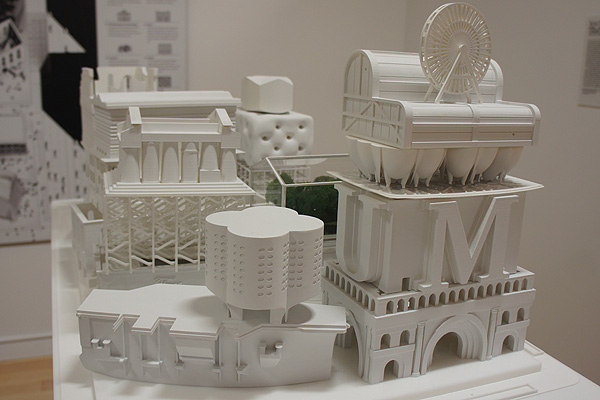
You'll find in there the shell of the old Prentice Hospital; the letters from Trump Tower; the Navy Pier Ferris wheel; a sinking neoclassical building called "The Titanic" in reference to a famous Tigerman piece. And the Harold Washington Library Center, upside down. "The roof is the best part of the Harold Washington Library," the architects write. However, it is only visible from far away. Pedestrians are greeted by a massive fortress at ground level. Why not put the best part on the ground so the public can see and use it?"
Architecture can also strip away bad ideas. My favorite exhibit comes from the Australian firm otherothers, which starts with the premise that "hidden within every suburban house is a great work of architecture."
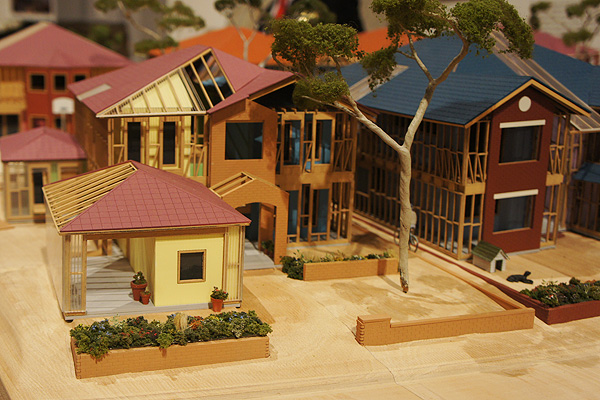
Offset House literally shrinks the suburban McMansion within itself. And in doing so runs a historical line through modern architecture—the balloon-frame design pioneered in 19th-century Chicago, the structure-as-style ideas of modernists such as Mies van der Rohe, and the adaptive reuse of the 21st century.
What else is architecture? How about camping? Like Gang, the Toronto-based firm Lateral Office ran through the history of camping architecture—from tents to campgrounds to RVs—and extended the idea out into the future, envisioning camps in the tree canopy or on floating dock islands, "a retreat from land itself."
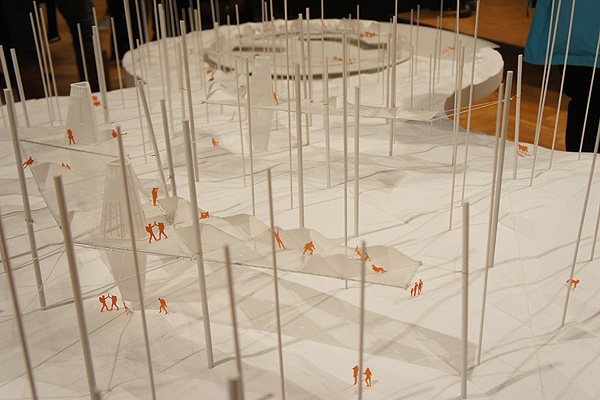
Architecture also includes the technologies that make building possible. One of the star exhibits is Rock Print from Gramazio Kohler Research in Zurich and MIT's Self-Assembly Lab.
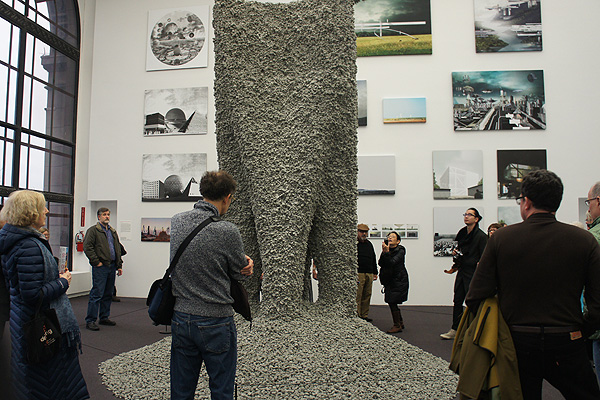
The structure looks like it could be a haunting piece of landscape architecture, but it's really proof-of-concept: "random-packed, poly-disperse structures that can be automatically fabricated in non-standard shapes." In this case: it's 3D printing with rocks and twine. No adhesive, no mortar.
"I find what Gramasio and Kohler, the Swiss duo, are doing with construction technology really interesting," says Geoff Manaugh, the longtime editor of architectural news site BLBGBLOG and another biennial participant. "The idea that you can take individual modules or units, and then find new ways of putting them together to end up with a built form at the end sounds incredibly basic. In fact, it sounds just like playing with building blocks."
Manaugh and his collaborators at Smout Allen took a heavily stylized look at where he lives—Los Angeles—with LA Recalculated, highlighting the scientific architecture and networks that make living there possible: "aspects of Los Angeles that are architectural and infrastructural, but tend to be treated more as background," Manaugh says. "Earthquake preparedness, seismicity, even the role that Los Angeles played in the early days of astronomy in the Western United States." From the earth's core, to the stars.
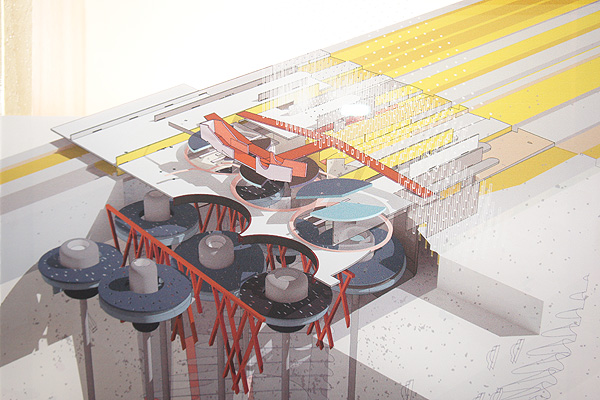
"If we're talking about the state of the art of architecture, we wanted to remind people that part of that is the collaborations that architecture gets into, when you're looking at scientific facilities, or when you're looking at the engineering of large structures in earthquake zones," Manaugh says. "You can't really talk about the state of the art in architecture unless you're also talking about these other uses of architecture and these other fields that get entangled with architecture and how it operates in a particular city."
And it can be otherworldly. Moon Hoon is an architect in Seoul, South Korea; his exhibit at the biennial consists of, literally, doodles—doodles he might do an an eight-hour "meditative session," but doodles nonetheless.
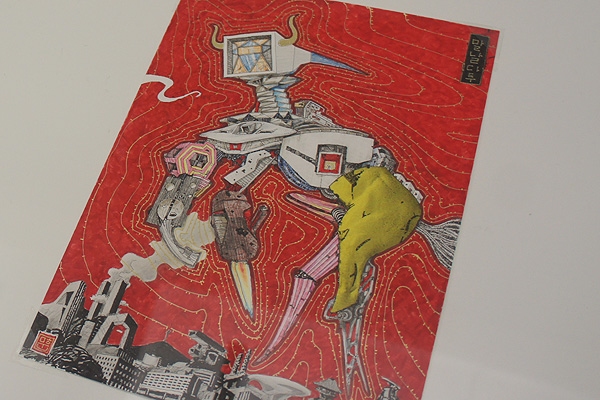
Is it architecture? It's on the spectrum; it's part of the process. Some of the biennial is seeing what architects do; some of it is seeing inside their heads, before architecture happens.
"There's a famous line by [the architect] Robin Evans that says, architects don't make buildings, architects make drawings and models of buildings," Hicks says. "Architects also make films and present ideas that are architectural through all sorts of mediums that aren't buildings. When people see all this media in different contexts, it does maybe feel a little closer to what's in the head of the architects. Because, in a sense, you're dealing with these media that are more directly produced by the architects themselves. Because there is this removal with buildings. Which is different than a sculptor or painter. In this kind of context, you can show drawings or models that the architect touched. With buildings, there's this degree of removal."
But it's also this.
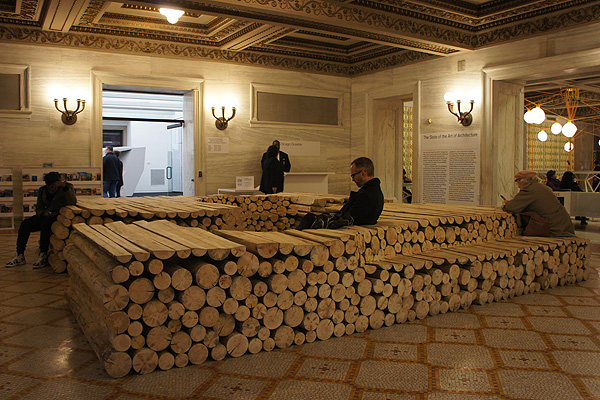
It's Place for Gathering, by Berlin-based Kéré Architecture, the firm of Francis Kéré, who grew up in rural Burkina Faso. He began as a carpenter, apprenticed as a developmental aid supervisor, and became an architect. Kéré's piece is something like a synthesis of Jeanne Gang's culturally engaged project and Sou Fujimoto's whimsical play with the fundamental concepts of architecture. It's wood, arranged in space, for people to come together in and talk.
"Architecture is omnipresent; it's incredibly exciting; it rewards all of these different approaches," Manaugh says. "Whether you're absolutely practical, or you've got your head in the clouds, either way you can find something really interesting in architecture. As a field, if the biennial can remind everybody [about architecture] and bring more people into the tent, so we can talk about architecture as a public and what it means for the city and for us individually, that would be a good takeaway."



